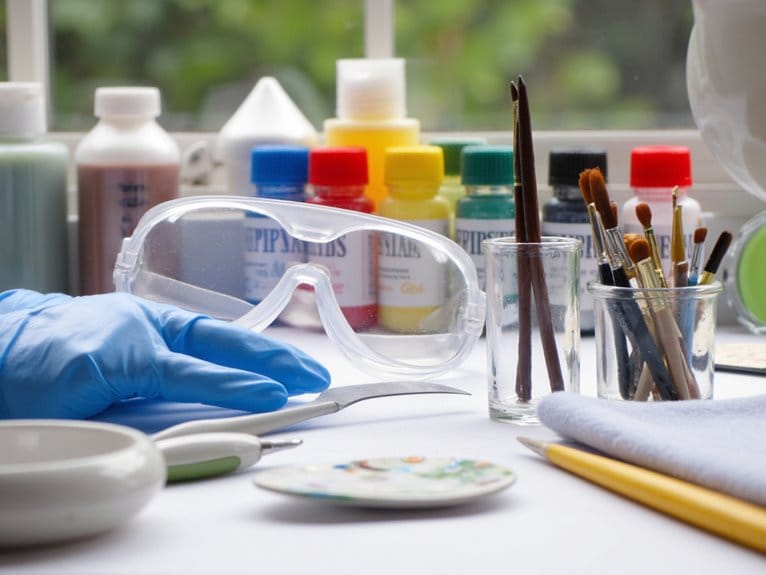We are supported by our audience. When you purchase through links on our site, we may earn an affiliate commission, at no extra cost for you. Learn more. Last update on 3rd July 2025 / Images from Amazon Product Advertising API.
I’d say a lightbox is essential for capturing stunning product images that showcase all the intricate details clearly and without distractions. The professional lighting guarantees your subject shines beautifully, creating that wow-factor. If you want to elevate your photography game and truly make your products stand out, a lightbox is definitely a game-changer.
Benefits of Using a Lightbox
Using a lightbox transforms ordinary product photography into engaging visual storytelling, enhancing every intricate detail with flawless lighting. LED lighting within a lightbox provides professional light quality, guaranteeing that product images are captured with precision. These portable photo studios are a game-changer for product photography, especially when it comes to small items. The even lighting produced by a lightbox is essential for highlighting the features of products effectively while reducing harsh shadows. By eliminating background distractions, a lightbox allows the subject to shine without any interruptions, creating a clean and focused image.
One of the significant advantages of using a lightbox is the ability to enhance the details and textures of small items. Whether it’s jewelry, electronics, or other intricate products, a lightbox can capture these elements with clarity, making them stand out in product photography. Additionally, the blank space surrounding the subject simplifies the editing process, enabling a cleaner final image without the need to remove distracting background elements manually. This streamlined workflow not only saves time but also ensures that the focus remains solely on the product itself, resulting in visually appealing and effective product photos.
Types of Lightboxes Available
When exploring the world of product photography, one encounters a diverse array of lightboxes tailored to meet various photography needs. Here are some types of lightboxes available:
- Studio Light Box: These larger lightboxes provide ample space for shooting products of varying sizes, allowing for more elaborate setups.
- LED Light: Many lightboxes come equipped with energy-efficient LED lights, offering bright and consistent illumination for clear and vibrant product photos.
- Portable Photo Studio Light: Compact and easy to transport, these lightboxes are ideal for photographers who need flexibility to shoot on-location or while traveling.
- Adjustable LED: Lightboxes with adjustable LED settings enable photographers to control the intensity of the light, allowing for precise lighting adjustments to suit different products.
- Interchangeable Backgrounds: Lightboxes featuring colored backdrops or interchangeable backgrounds give photographers the freedom to create diverse looks for product photography, adding versatility to their images.
Each type of lightbox serves a specific purpose in enhancing product photography, catering to different preferences and shooting requirements. Whether you need a stationary setup for consistent lighting or a portable solution for flexibility, there is a lightbox available to meet your unique needs in the world of product photography.
Factors to Consider Before Buying
Size matters in the world of lightboxes, influencing the ease of post-processing and flexibility for your photography needs. When examining a lightbox, the dimensions will determine the types of products or items you can photograph effectively. A larger lightbox provides more space to accommodate bigger products, allowing for various shooting angles without constraints. On the other hand, a smaller lightbox might be more suitable for compact items or tight shooting spaces, ensuring a snug fit for your subjects.
Another important factor to evaluate is the lighting options available in the lightbox. Some models come equipped with integrated LED lights, providing convenient illumination for your product photography. Alternatively, there are lightboxes without built-in lights, offering you full control over the lighting setup. This flexibility allows you to experiment with different lighting techniques and adjust the brightness according to your preferences.
Background options are also vital to take into account before making a purchase. Lightboxes with built-in white backgrounds offer a classic and versatile backdrop for product photography. Additionally, models with interchangeable background materials enable you to customize the look of your photos, catering to various styles and themes. Whether you prefer a clean, minimalist aesthetic or a more creative backdrop, the choice of background can greatly impact the overall appearance of your product photos.
Tips for Effective Lightbox Usage
Exploring the nuances of effective lightbox utilization reveals key insights into enhancing the visual impact of your projects. When setting up your photo box, make sure the position of the light source provides uniform lighting across the subject, eliminating harsh shadows that can detract from the image quality. Experiment with different lighting angles within the lightbox to control how light interacts with your small objects, emphasizing textures and intricate details for stunning results.
For product photography, lightboxes excel at capturing clean, simple images that highlight the product without the distraction of dynamic backgrounds. By eliminating background distractions, you can create professional and polished photos that draw the viewer’s eye directly to the subject. Remember, the key to successful lightbox usage lies in the careful arrangement of your setup to achieve the desired effect.
Whether you’re focusing on small objects or product photography, mastering the art of lightbox usage can elevate your images to new heights. By paying attention to lighting angles, achieving uniform lighting, and minimizing background distractions, you can create visually appealing and enthralling photos that showcase your subjects in the best possible light.


